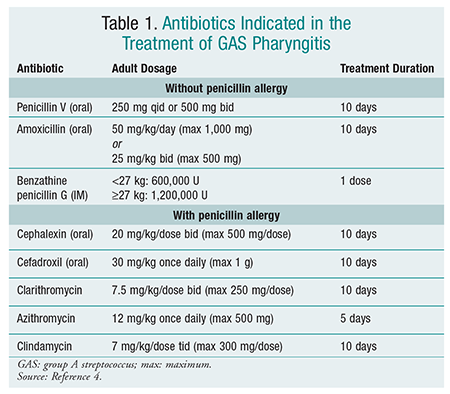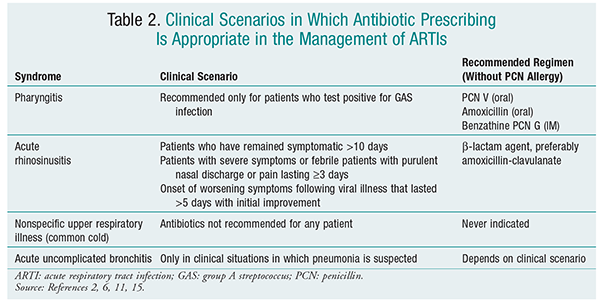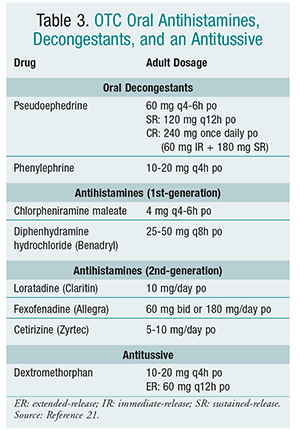US Pharm. 2016;41(7):HS16-HS19.
ABSTRACT: The public-health and financial effects of inappropriate use of antibiotics for acute respiratory tract infections (ARTIs) continue to rise. Adverse effects, antibiotic prescription costs, and antibiotic resistance continue to be negative factors associated with unnecessary prescribing of antibiotics for ARTIs. ARTIs—including pharyngitis, rhinosinusitis, acute uncomplicated bronchitis, and the common cold (nonspecific upper respiratory infection)—are often attributed to viral syndromes, which limits the benefit of antibiotics for these infections. Pharmacists can play a unique role in educating patients and providers about the impact of inappropriate prescribing, making alternative nonprescription recommendations to providers and patients who are seeking options for symptom alleviation, and working at the forefront of antibiotic stewardship efforts.
Acute respiratory tract infections (ARTIs) comprise four different syndromes: pharyngitis, rhinosinusitis, acute uncomplicated bronchitis, and the common cold (nonspecific upper respiratory infection). Antibiotic use for ARTIs continues to be a major public-health concern. Despite limited evidence of a benefit from prescribing antibiotics for ARTIs, 41% of all prescriptions made annually in ambulatory care settings are for acute respiratory conditions.1,2 In numerous instances, these syndromes may be attributed to viral infections; therefore, the clinical utility of prescribing antibiotics in such cases is limited.
Pharyngitis
Pharyngitis (inflammation of the pharyngeal tissues) is generally a self-limiting condition characterized by a sore throat that feels worse with swallowing.2 Although most pharyngitis episodes are viral in origin, antibiotics are prescribed at most ambulatory care visits, and more than 60% of adults presenting with sore throat receive antibiotics.2,3 Even given the relatively high incidence of viral origin, the potential still remains for bacterial pathogens to be the underlying cause. Group A streptococcus (GAS), the most common bacterial pathogen associated with pharyngitis, may be detected via rapid antigen detection tests.2,4 Clinical scoring criteria can help determine the likelihood of bacterial infection.2 Current guidelines advise prescribers to determine the presence of bacterial pathogens before prescribing antibiotics.2
Treatment Strategies: According to current treatment guidelines, antibiotic use is indicated only in patients who test positive for streptococcal infection.4 In patients who are confirmed positive for the presence of GAS infection, penicillin and amoxicillin are the drugs of choice (TABLE 1).4,5 Alternatives for penicillin-allergic patients include first-generation cephalosporins (only in patients without anaphylactic penicillin reaction), clindamycin, clarithromycin, and azithromycin.4,5

Acute Rhinosinusitis
This condition, which is an inflammation of the mucosal lining of the nasal passage and paranasal sinuses, may involve symptoms of nasal congestion, nasal discharge, facial pressure or pain, fatigue, cough, ear pain, and headache, among other clinical features.6 Viral infections account for 90% to 98% of all cases of acute rhinosinusitis, whereas bacterial infections are estimated to be responsible for 2% to 10% of cases.7 Although there is ample evidence that viral infections are the most prominent cause, more than 80% of all ambulatory care visits for rhinosinusitis result in antibiotic prescriptions.2,8,9
Determining whether the etiology is viral or bacterial may pose a challenge for many clinicians because limited diagnostic testing is available to determine the underlying pathogenic cause of acute bacterial rhinosinusitis (ABRS).2 Sinus puncture with aspiration of purulent material is the gold standard in diagnosing ABRS; however, this procedure is infrequently performed.2,6 Current treatment recommendations promote the use of clinical signs and symptoms to determine bacterial versus viral origin (TABLE 2), with empiric antibiotic therapy recommended only for patients displaying signs and symptoms of ABRS.2,6

Treatment Approaches: Empiric antibiotic therapy should be used only in patients displaying signs and symptoms of ABRS, with either amoxicillin-clavulanate or doxycycline as the preferred therapy.6 Respiratory fluoroquinolones may be considered as alternatives for adult patients who are allergic to penicillin.2,6 It is important to note that differences in suggested treatment strategies exist among various professional societies, with some guidelines recommending no antibiotic therapy as initial management or the use of alternative antimicrobial agents, such as amoxicillin.2
Nonspecific Upper Respiratory Illness
Informally known as the common cold, nonspecific upper respiratory illness may present as a mild viral disorder with a variety of symptoms including, but not limited to, sore throat, cough, malaise, headache, and low-grade fever.2 As with other ARTI syndromes, the common cold is most often attributed to viral infection and may spread through various routes of transmission.2 Three percent of all ambulatory care visits are for the common cold, and although there is evidence that a qlimited number of cases are bacterial in origin, an estimated 30% of these visits result in antibiotic prescriptions.2,10 The presence of purulent nasal discharge and/or sputum is sometimes used to differentiate between bacterial and viral etiologies.11 However, when it is not accompanied by additional factors, such as illness lasting longer than 7 days, purulent discharge is a weak predictor of bacterial infection in adults with upper respiratory tract infection.11
Treatment Approaches: Although the benefit of antibiotic treatment in reducing complications of nonspecific upper respiratory tract infections has not been studied in adults, antibiotics should not be recommended or prescribed for treatment.2,11 Symptomatic therapy alone, including antihistamine-analgesic decongestants, antitussives, and analgesics, should be the primary recommendation for patients seeking treatment for the common cold (TABLE 3).2

Acute Uncomplicated Bronchitis
This condition is an inflammation of the large airway that presents with a cough that may last up to 6 weeks.2 Acute bronchitis, one of the most common adult outpatient diagnoses, has been found to result in more incidences of inappropriate antibiotic prescribing than any other ARTI syndrome in adults.2,12 In a randomized, double-blind, placebo-controlled clinical trial that investigated the benefits of erythromycin in patients diagnosed with acute bronchitis, erythromycin significantly reduced lost time from work; however, it had limited efficacy in reducing cough or other symptoms in patients with acute bronchitis.13 Additionally, a retrospective cross-sectional study that analyzed antibiotic use for ARTIs in a population of veterans concluded that 100% of patients diagnosed with acute bronchitis or acute sinusitis received prescriptions.14 As is the case with other ARTI syndromes, it may be challenging to determine the etiology of acute bronchitis, particularly in clinicians having to distinguish between acute bronchitis and pneumonia.2 However, other clinical features, such as age, presence of tachycardia, tachypnea, fever, and abnormal findings on chest examination, may be used to determine the cause.2,15
Treatment Approaches: Current treatment guidelines recommend against the use of antibiotics in the management of acute bronchitis.2 Therefore, symptomatic relief with cough suppressants (dextromethorphan or codeine), expectorants (guaifenesin), first-generation antihistamines (diphenhydramine), decongestants (phenylephrine), and beta-agonists (albuterol) may serve as alternatives.2
Alternative Therapies for ARTI
Symptom management is critically important in patients with ARTIs not meeting criteria for antibiotic prescription. Topical or systemic decongestants, mucolytics, antihistamines, saline nasal irrigation, and intranasal corticosteroids are favorable options for symptom management.2 Analgesics, anti-inflammatory agents, and throat lozenges may be recommended for patients seeking pain relief.2 Aspirin therapy should be avoided in children because of the risk of Reye syndrome.4 Patients diagnosed with acute rhinosinusitis whose symptoms persist for more than 10 days should be reevaluated for the presence of bacterial causes.6
Economic and Public-Health Impact of Inappropriate Antibiotic Prescribing
The public-health and financial effects of inappropriate use of antibiotics for ARTIs continue to climb. Antibiotic prescription costs, adverse events (AEs), and antibiotic resistance remain negative factors associated with unnecessary prescribing of antibiotics for ARTIs.2 In an evaluation of antibiotic expenditures by healthcare setting and antibiotic class, Suda and colleagues concluded that antibiotic prescriptions totaled $10.7 billion in 2009, with 62% of these costs attributed to antibiotic prescribing in the community setting (particularly community pharmacies).16 With 41% of all annual prescriptions in ambulatory care settings being written for acute respiratory conditions despite limited evidence of antibiotics’ benefit in such illnesses, it is evident that many of these antibiotic prescriptions are unnecessary.1,2
AEs resulting from the use of inappropriate antimicrobial prescribing pose a significant burden. The use of antibiotics in syndromes that do not require antimicrobial treatment can increase a patient’s risk of developing AEs such as Clostridium difficile, rash, and even Stevens-Johnson syndrome.17 Although data are limited on the percentage of AEs that result from inappropriate antibiotic prescribing, it is estimated that 5% to 25% of patients taking antimicrobials will experience an AE, with 1 in 1,000 having a serious AE.17 Furthermore, in 2013 the CDC published information related to the burden of antibiotic resistance on public health. Each year, two million individuals in the United States become infected with resistant bacteria, and at least 23,000 people die as a result, illustrating the serious and widespread nature of the problem of antibiotic resistance.17 In addition, the Infectious Diseases Society of America guidelines for rhinosinusitis report that multiple pathogens are resistant to therapy, which may be a direct result of inappropriate prescribing.6 All of these factors should be key considerations and form the basis for education to reduce inappropriate prescribing.
Pharmacist’s Role in Improving Antibiotic Prescribing for ARTIs
A survey of clinical pharmacists’ knowledge of the appropriateness of antimicrobials for the treatment of ARTIs found that pharmacists recommended antibiotics for treatment of both upper respiratory infections (URIs) and acute bronchitis significantly more often, based primarily on the presence of discolored nasal discharge.18 Although it was published more than a decade ago, this survey indicates that misconceptions among not only prescribers, but also pharmacists, may exist in the management of patients diagnosed with ARTIs. Pharmacist and prescriber education on current practice recommendations is crucially important for reducing the unnecessary use of antimicrobials for ARTIs.
In the inpatient setting, pharmacist intervention to reduce the use of antimicrobials may also be beneficial. A study by Shen and colleagues evaluated the impact of pharmacist interventions on antibiotic use in inpatients in a tertiary hospital who had respiratory tract infections. The total cost of hospitalization for the intervention group was significantly lower compared with that for the control group ($1,442.3 ± 684.9 vs. $1,729.6 ± 773.7, P <.001), as was the cost of antibiotics ($832.0 ± 373.0 vs. $943.9 ± 412.0, P = .01); intervention patients also had a shorter hospital stay.19
Community, ambulatory care, and emergency department pharmacists may serve as a valuable resource for patients and providers attempting to determine appropriate nonprescription options for symptomatic management of ARTIs. In addition to providing options for symptom relief, pharmacists can also educate patients on differences between viral and bacterial infections and the relatively low incidence of bacterial pathogens causing ARTIs. Research has demonstrated that supplying the necessary information about the patient’s symptoms at the first encounter in the pharmacy can deter patients from seeking antibiotics from physicians.20
Education continues to be the best method for improving and reducing antibiotic prescribing for ARTIs, as well as for decreasing the unnecessary use of antibiotics. Numerous studies have proven that antibiotics are of limited benefit in patients diagnosed with ARTIs; however, alternative recommendations should be provided to manage the symptoms of ARTIs.
REFERENCES
1. Shapiro DJ, Hicks LA, Pavia AT, Hersh AL. Antibiotic prescribing for adults in ambulatory care in the USA, 2007-09. J Antimicrob Chemother. 2014;69:234-240.
2. Harris AM, Hicks LA, Qaseem A; High Value Care Task Force of the American College of Physicians and the Centers for Disease Control and Prevention. Appropriate antibiotic use for acute respiratory tract infection in adults: advice for high-value care from the American College of Physicians and the Centers for Disease Control and Prevention. Ann Intern Med. 2016;164:425-434.
3. Barnett ML, Linder JA. Antibiotic prescribing to adults with sore throat in the United States, 1997-2010. JAMA Intern Med. 2014;174:138-140.
4. Shulman ST, Bisno AL, Clegg HW, et al. Clinical practice guideline for the diagnosis and management of group A streptococcal pharyngitis: 2012 update by the Infectious Diseases Society of America. Clin Infect Dis. 2012;55:1279-1282.
5. Spinks A, Glasziou PP, Del Mar CB. Antibiotics for sore throat. Cochrane Database Syst Rev. 2013;(11):CD000023.
6. Chow AW, Benninger MS, Brook I, et al. IDSA clinical practice guideline for acute bacterial rhinosinusitis in children and adults. Clin Infect Dis. 2012;54:e72-e112.
7. Gwaltney JM Jr, Wiesinger BA, Patrie JT. Acute community-acquired bacterial sinusitis: the value of antimicrobial treatment and the natural history. Clin Infect Dis. 2004;38:227-233.
8. Fairlie T, Shapiro DJ, Hersh AL, Hicks LA. National trends in visit rates and antibiotic prescribing for adults with acute sinusitis [letter]. Arch Intern Med. 2012;172:1513-1514.
9. Garbutt JM, Banister C, Spitznagel E, Piccirillo JF. Amoxicillin for acute rhinosinusitis: a randomized controlled trial. JAMA. 2012;307:685-692.
10. Schappert SM, Burt CW. Ambulatory care visits to physician offices, hospital outpatient departments, and emergency departments: United States, 2001-02. Vital Health Stat 13. 2006;159:1-66.
11. Gonzales R, Bartlett JG, Besser RE, et al. Principles of appropriate antibiotic use for treatment of nonspecific upper respiratory tract infections in adults: background. Ann Intern Med. 2001;134:490-494.
12. Grijalva CG, Nuorti JP, Griffin MR. Antibiotic prescription rates for acute respiratory tract infections in US ambulatory settings. JAMA. 2009;302:758-766.
13. King DE, Williams WC, Bishop L, Shechter A. Effectiveness of erythromycin in the treatment of acute bronchitis. J Fam Pract. 1996;42:601-605.
14. Franck AJ, Smith RE. Antibiotic use for acute upper respiratory tract infections in a veteran population. J Am Pharm Assoc (2003). 2010;50:726-729.
15. Gonzales R, Bartlett JG, Besser RE, et al. Principles of appropriate antibiotic use for treatment of uncomplicated acute bronchitis: background. Ann Intern Med. 2001;134:521-529.
16. Suda KJ, Hicks LA, Roberts RM, et al. A national evaluation of antibiotic expenditures by healthcare setting in the United States, 2009. J Antimicrob Chemother. 2013;68:715-718.
17. CDC. Antibiotic Resistance Threats in the United States, 2013. www.cdc.gov/drugresistance/threat-report-2013. Accessed March 30, 2016.
18. Mainous AG III, MacFarlane LL, Connor MK, et al. Survey of clinical pharmacists’ knowledge of appropriateness of antimicrobial therapy for upper respiratory infections and acute bronchitis. Pharmacotherapy. 1999;19:388-392.
19. Shen J, Sun Q, Zhou X, et al. Pharmacist interventions on antibiotic use in inpatients with respiratory tract infections in a Chinese hospital. Int J Clin Pharm. 2011;33:929-933.
20. Fleming N, Barber S, Shiru-Oredope D. Pharmacists have a critical role in the conservation of effective antibiotics. Pharmaceutical J. 2011;287:465.
21. May JR, Smith PH. Allergic rhinitis. In: DiPiro JT, Talbert RL, Yee GC, et al, eds. Pharmacotherapy: A Pathophysiologic Approach. 9th ed. New York, NY: McGraw-Hill Education; 2014.
To comment on this article, contact rdavidson@uspharmacist.com.






